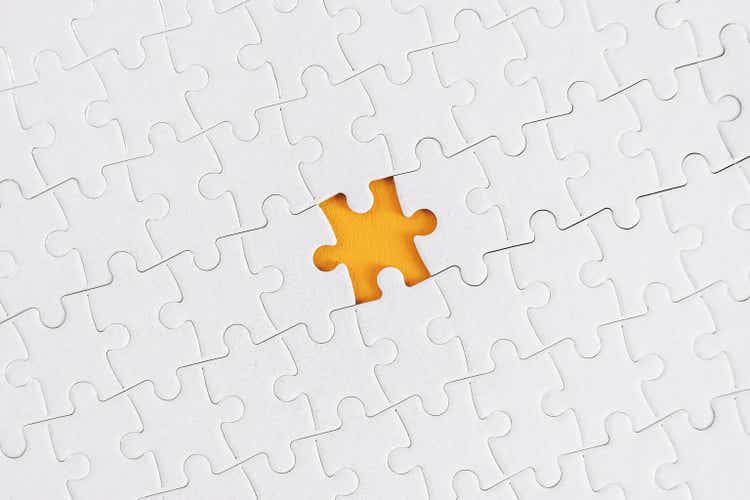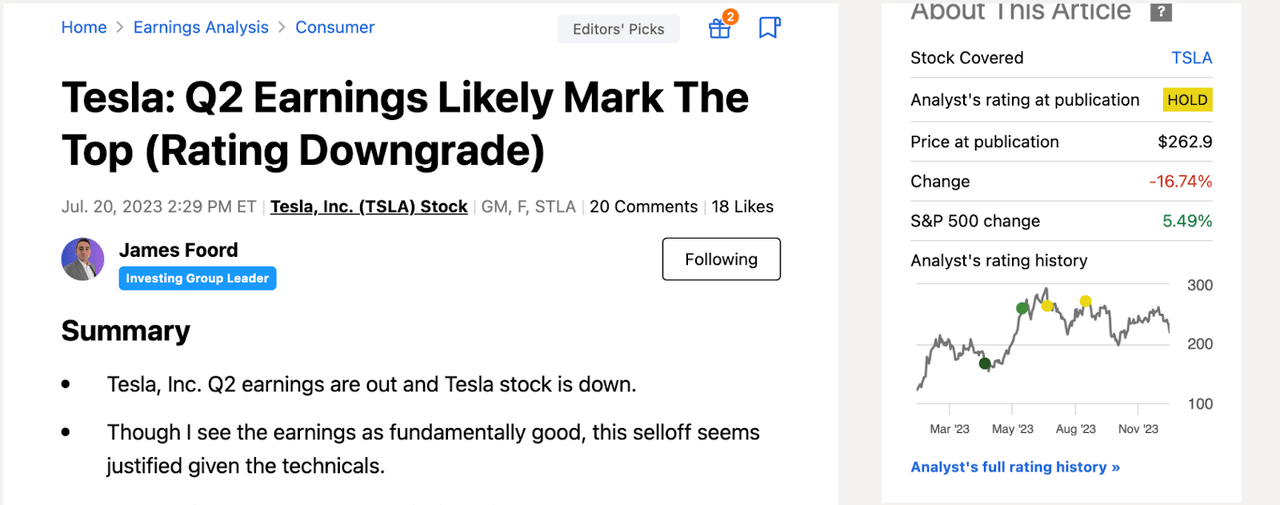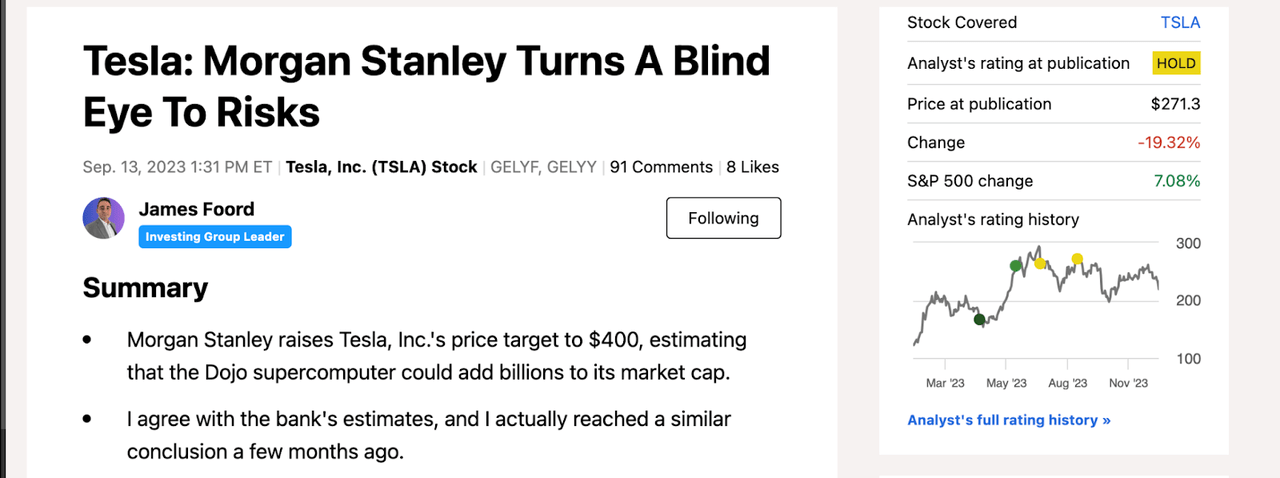
Uncovering Tesla’s Long-Term Potential
Tesla (NASDAQ:TSLA) has experienced a stagnant stock price over the past six months. After several fluctuations, the current price resembles that of August levels.
However, in the last month, Tesla has declined by over 7%, as the market incorporates more negative news into its valuation.
Although Tesla is no longer the top electric vehicle (“EV”) seller over the last quarter, and encounters mixed reviews and recalls, the market’s myopic view is missing some crucial long-term potential the company still holds.
Contrary to the prevailing sentiment, Tesla’s stock is arguably undervalued by historical standards. Surprisingly, this low valuation comes at a time when Tesla has made substantial progress in its Energy, full self-driving (“FSD”), and charging segments, which are poised to be more financially impactful than car sales in the future.
Diving into the potential profitability of these segments over the next 7 years lends more support to a compelling investment case.
Simply put, this apparent pullback in Tesla’s stock presents an opportunity worth seizing for discerning investors.
Sizing Up Recent Developments
Although I have previously maintained a neutral stance on Tesla, recent events warrant a pivotal reevaluation.
During the 2023 Q2 earnings, despite significant upward momentum, I offered a neutral rating based mostly on Technical Analysis.

Similarly, on another occasion, despite my bullish long-term conviction, I adopted a neutral outlook following Morgan Stanley’s (MS) price target upgrade to $400. This was underpinned by concerns that the short-term optimism ignored the risks associated with China.

Yet, it seems that many of the negative factors have already been factored into the market sentiment. Out of the last 10 SA articles on Tesla, opinions are evenly divided, suggesting a shift in sentiment among investors.
The Bearish Case
Admittedly, there are ample reasons to adopt a bearish outlook on Tesla, especially in light of recent developments.
Supply Constraints
The temporary shutdown of Tesla’s largest factory in Europe, the Berlin Gigafactory, due to delayed key components, presents a troubling supply chain challenge. With the potential pause in output for an extended period, this exacerbates the strain caused by the underwhelming response to the Cybertruck release.
The Cybertruck Conundrum and Other Challenges
Following the commencement of Cybertruck deliveries, early videos depicting the vehicle’s struggles in adverse conditions and an unofficial test revealing deviations in advertised range raise questions about its immediate success in the market.
These tribulations with the Cybertruck are not unexpected, given its complex production, as emphasized by Elon Musk himself. Despite Musk’s estimates of substantial sales, the impact on the company’s bottom line remains uncertain.
Moreover, the recent recall of 2 million vehicles due to inadequate monitoring of drivers using self-driving capabilities adds another layer of complexity and concern.
Decline in Demand
Compounding these challenges, the loss of Tesla’s top EV seller status and dwindling sales add to the mounting headwinds faced by the company.
The Future of Tesla: A Bright Outlook for Investors
Tesla, the American electric vehicle and clean energy company, has been facing stiff competition and a dwindling market share in China. While these might seem like substantial hurdles, they are merely short-term challenges in the larger tapestry of Tesla’s future prospects.
It is no secret that Tesla has faced increasing competition in its core markets, not just from other electric vehicle (EV) manufacturers, but also from traditional car companies venturing into the electric and hybrid vehicle space. The cacophony surrounding Tesla in recent months, however, is akin to mere background noise. As an investor with a long-term perspective, these are transient ripples in the fabric of the company’s trajectory.
Looking ahead, Tesla is poised to undergo a significant transformation. While its current revenue stream is predominantly derived from EV sales, the company is on track to diversify into other segments, where the margins are vastly superior to conventional auto production.
Expanding Revenue Streams
In the coming years, Tesla’s revenue landscape is set to evolve. The burgeoning energy storage sector, in particular, holds immense promise for bolstering the company’s revenue and earnings. Unlike the low-margin nature of auto production, energy storage ventures boast margins that already surpass those of Tesla’s primary business.
Drawing parallels to Amazon Web Services, Tesla’s energy storage arm, exemplified by the Megapack business, is primed for robust growth with substantially higher margins, akin to a higher-yielding crop in a lush garden.
The renewable energy landscape is on the cusp of a tectonic shift, with Tesla at the vanguard. A recent milestone for the company was the acquisition of a 1.6 GWh Megapack project with the Melbourne Renewable Energy Hub, underscoring the upward trajectory of its energy storage pursuits.
According to industry insights from Verified Market Research, the global energy storage market is projected to burgeon to $32.5 billion by 2030, exhibiting a robust compound annual growth rate (CAGR) of 16.3%. Strikingly, Tesla harbors even more ambitious growth aspirations, eyeing a staggering 1,500 GWh in annual energy storage deployment, tantamount to an approximately 90% CAGR for this segment.
Revolutionizing Transportation
Tesla’s full self-driving (“FSD”) technology has transcended the realm of conceptualization, evolving into an operational segment that is already contributing an estimated $1-3 billion to the company’s sales, despite being in beta mode. With Tesla levying an upfront fee of $12,000 for FSD, along with a monthly subscription model, the revenue potential is substantial.
Furthermore, analysts at Goldman Sachs have forecasted that FSD could yield an astonishing $75 billion in revenues for Tesla by 2030, solidifying its status as a transformative force in the transportation landscape.
Charging Ahead
In tandem with its forays into energy storage and autonomous driving, Tesla’s charging infrastructure is poised to be a pivotal growth catalyst in the foreseeable future. The company’s supercharger network, a ubiquitous feature for Tesla vehicle owners, has garnered widespread acclaim and is now evolving into a veritable goldmine for investors.
The recent integration of Tesla’s chargers by prestigious automotive marques such as Volkswagen, Porsche, and Audi, coupled with favorable overtures from the White House regarding standardization, underscores the ascendancy of Tesla in the charging arena. This strategic positioning is reminiscent of the proverbial pick-and-shovel play in the gold rush, wherein the company that dominates the charging market stands to reap substantial rewards.
An Optimistic Outlook
In projecting Tesla’s trajectory for 2030, the convergence of these various segments portends a scenario of exceptional annual revenue potential. This augurs well for investors eyeing Tesla’s long-term prospects.
Energy Storage Forecast
Amidst Tesla’s forward-looking projections, a comprehensive analysis of the company’s energy storage endeavors reveals a promising trajectory. Despite ambitious assertions from Tesla’s CEO, Elon Musk, it is imperative to adopt a discerning stance. Tesla’s pledge to scale up energy production and storage to 1,500 GWh by 2030, though seemingly audacious, warrants cautious evaluation.
On a more conservative note, a tempered estimate that recognizes Tesla’s potential to capture a significant market share and uphold a pivotal role in deploying and maintaining 500 GWh of energy storage by 2030 is a grounds for optimism. This promising outlook delineates Tesla’s ascension as a formidable force in the renewable energy domain.
Embracing the Thunder: Tesla’s Meteoric Potential
Energy Storage: An Electrifying Start
Tesla’s dominance in the energy storage sector is nothing short of staggering. Their capacity to produce 250 GWh in batteries by 2030 is truly awe-inspiring. Considering the historical growth patterns, with a CAGR of nearly 100%, the company is poised to produce a mind-blowing $217 billion in revenues. This translates to a gross profit of $54.24 billion, maintaining a consistent upward trajectory.
Full Self-Driving (FSD) Valuation
Tesla’s Full Self-Driving technology is not just an idea but a monumental game-changer. With Goldman’s estimates projecting up to $70 billion in revenues for FSD, it’s clear that Tesla is headed for the stratosphere. A 40% CAGR target by 2030 may seem ambitious, but with a more modest CAGR of 30%, the projection of 12 million units is a clear testament to Tesla’s extraordinary potential.
Charging: A Jolt of Innovation
Tesla’s foray into the world of charging stations is electrifying. With an estimated 350 million EVs on the road by 2030, their Supercharger network stands to generate a jaw-dropping $163 billion in annual revenues, with a staggering $48.9 billion in gross profit. The massive scale of this operation promises a seismic shift in Tesla’s financial landscape.
Car Sales: Accelerating Growth
Tesla’s projected production of 12 million units by 2030 heralds an era of unprecedented growth. With an average price of roughly $60,000 per vehicle, the company is set to reel in a massive $720 billion in revenue, with an impressive $144 billion in gross profit. This projection indicates a trajectory that is nothing short of supernova-like in its potential.
Valuation: Shooting for the Stars
In summary, Tesla’s 2030 projected revenues of $1.2 trillion and gross profits of $362.3 billion exemplify a financial performance that is truly stratospheric. While the application of a Price/Gross Profit ratio projects a target price of $4100, a more realistic viewpoint suggests a potential target price of $775. An appraisal that is firmly grounded yet echoes the celestial potential of this trailblazing company.
Final Thoughts: A Paradigm Shift
While myopic market sentiments may cloud the immediate horizons, the transformative strides Tesla is making in energy storage, charging infrastructure, and FSD are reshaping the long-term investment landscape. The company’s trajectory is nothing short of a breathtaking thunderstorm, with opportunities flashing like lightning on the horizon.
Editor’s Note: This article discusses one or more securities that do not trade on a major U.S. exchange. Please be aware of the risks associated with these stocks.









